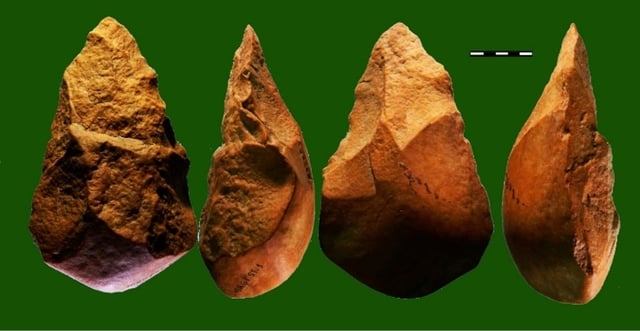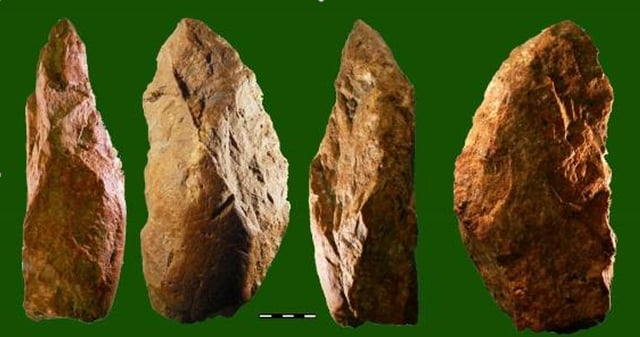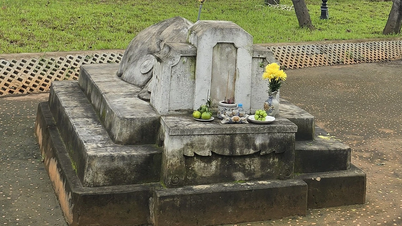Shocking artifacts
In March 2019, the whole town of An Khe (Gia Lai province) was "hot" because of the International Scientific Conference on An Khe Paleolithic Industry, organized by the People's Committee of Gia Lai province and the Vietnam Academy of Social Sciences, the Russian Academy of Sciences. There, archaeologists admired thousands of valuable stone artifacts, excavated from intact geological layers.
Dr. Nguyen Gia Doi, then acting director of the Institute of Archaeology, said that artifacts such as two-sided stone tools, especially hand axes, "bear the characteristics of hand axes from the earliest period of mankind." Now, the collection of An Khe early Paleolithic tools has been recognized as a national treasure in the 2022 recognition period.

Roc Gao hand axe
Gia Lai Provincial Museum said the collection includes 10 artifacts. They are all original artifacts, found in typical archaeological sites of the An Khe Paleolithic industry, during the period 2014 - 2019. "These are also intact, unique hand axes/single-sided hammering tools/double-sided hammering tools, unlike any tools made by primitive people 800,000 years ago in An Khe in particular and Vietnam in general," the museum's documents said.
This group of artifacts includes: Go Da hand axe; Roc Tung hand axe; Roc Lon hand axe; Roc Gao hand axe; Roc Lon single-sided axe; Roc Tung 1 spike; Roc Tung 10 triangular spike; Roc Huong triangular spike; Go Da triangular spike; Roc Tung 4 triangular spike.
According to the national treasure dossier, the collection of 10 stone tools above is a typical artifact of the An Khe Paleolithic industry, located in a geological layer dating to the early Pleistocene period and with an average radioactive isotope age of 800,000 years ago.
According to the records, the absolute age of the An Khe industry was determined by the Potassium - Argon radioactive isotope method (40K/40Ar) at the IGEM RAN Geochemical and Geochronological Isotope Laboratory - Russian Academy of Sciences. "From the archaeological and aesthetic point of view, these tools were all made with great effort by Paleolithic people, crafted with high technology, creating tools with symmetrical shapes, demonstrating the high level of thinking and aesthetics of people 800,000 years ago," the treasure records stated.
Specifically, the tools have reached the pinnacle of double-sided hammering technique - a major innovation in stone tool making technology; at the same time demonstrating the intelligent adaptability of humans here to an environment rich in bamboo and rattan like Vietnam. Scientists even said: "The single-sided hammering/double-sided hammering tools in the An Khe Paleolithic industry also have significant differences and uniqueness compared to the rest of the Eurasian region, deserving to be present in the world's map of the distribution of the early Paleolithic double-sided hammering technology".

Roc Tung hand axe
National treasure of the Department of Cultural Heritage
Extending history
According to the treasure records, the collection of An Khe Paleolithic tools is vivid evidence of the culture of the Paleolithic community about 800,000 years ago on An Khe land and is also the starting point of Vietnamese history.
"For a long time, the beginning of Vietnamese history was 500,000 years ago with the appearance of Homo erectus in Tham Khuyen and Tham Hai (Lang Son). With the discovery of the An Khe hand axe and the dating of the two relics Go Da and Roc Tung (both in An Khe town), now the beginning of Vietnamese history is confirmed to be much older, around 800,000 years ago," the file said.
Also according to the records: "An Khe industry is now known as one of the places that preserves cultural traces of human ancestors - Homo erectus".
This collection has even greater significance when it rejects the view of researcher H.Movius put forward more than 70 years ago, according to which he divided human history into two opposing regions, East and West. In the West, hand axes with balanced and standardized shapes are popular, representing progress and dynamism; while in the East, the long-standing chopper-chopping industry, which is primitive and depends on the natural shape of the pebbles, represents a conservative, stagnant, backward region and has almost no contribution to the progress of humanity.
In addition, the collection also shakes the view of how humans were formed. Previously, most opinions believed that the first humans were formed in Africa. These people moved to Europe, then Asia, bringing with them the double-sided hammering technology with hand axes to the new land. "The discovery of very early hand axes in An Khe and some other places in Asia is the basis for reconsidering the above hypothesis, as well as the evolution of mankind in the early Paleolithic period globally," the treasure dossier said.
Currently, the People's Committee of An Khe Town has invested in building a permanent exhibition house and a number of houses to preserve archaeological heritages after excavation at the site, as a long-term sightseeing, learning and research destination for domestic and foreign visitors.
(to be continued)
Source: https://thanhnien.vn/bo-cong-cu-da-an-khe-noi-them-30-van-nam-lich-su-viet-nam-185230209000956223.htm


![[Photo] Prime Minister Pham Minh Chinh chairs a meeting of the Government Standing Committee on overcoming the consequences of natural disasters after storm No. 11](https://vphoto.vietnam.vn/thumb/1200x675/vietnam/resource/IMAGE/2025/10/09/1759997894015_dsc-0591-jpg.webp)
![[Photo] General Secretary To Lam visits Kieng Sang Kindergarten and the classroom named after Uncle Ho](https://vphoto.vietnam.vn/thumb/1200x675/vietnam/resource/IMAGE/2025/10/09/1760023999336_vna-potal-tong-bi-thu-to-lam-tham-truong-mau-giao-kieng-sang-va-lop-hoc-mang-ten-bac-ho-8328675-277-jpg.webp)

![[Photo] President Luong Cuong attends the 80th Anniversary of the Traditional Day of Vietnamese Lawyers](https://vphoto.vietnam.vn/thumb/1200x675/vietnam/resource/IMAGE/2025/10/09/1760026998213_ndo_br_1-jpg.webp)































































































Comment (0)